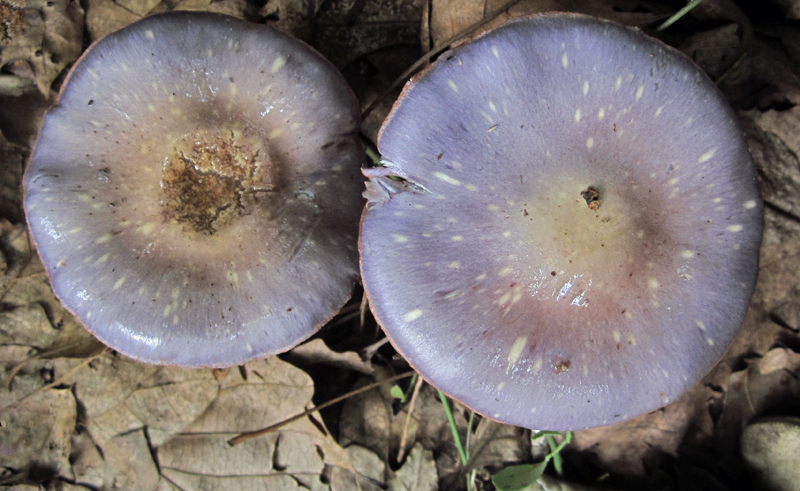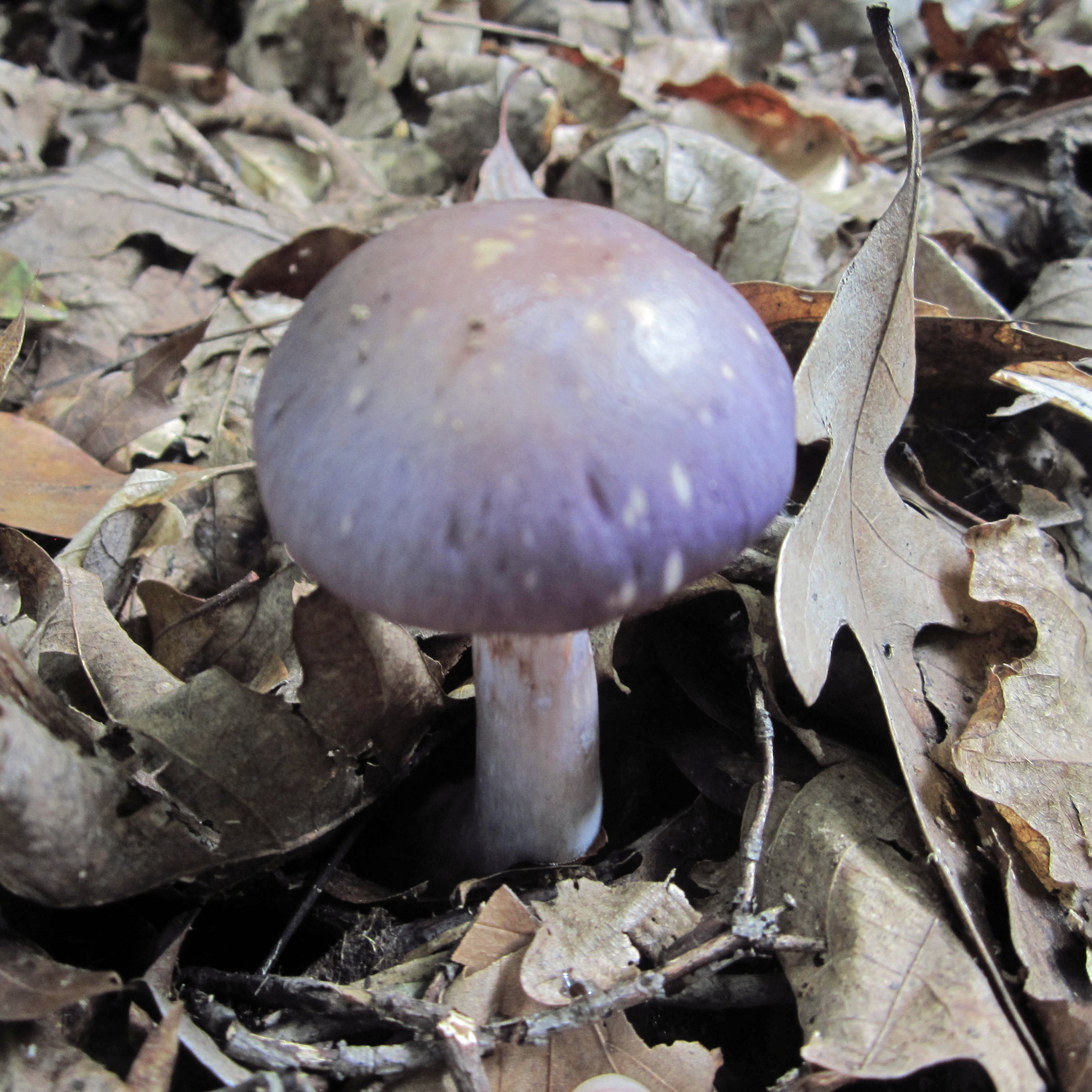Map Snapshot

















64 Records
Status
Found scattered or in groups on ground under hardwoods.
Description
Dark lilac/purple, fading in age and developing yellow spots, yellowish umbo; Smooth, slimy; bell-shpaed, broadly convex in age; margin inrolled, may have veil fragments; flesh white, then gray. Gills: lilac becoming grayish-cinnamon in age; close. Stalk: Violet, sometimes white toward base; slimy, smooth; may have pale violet partial veil near top (J. Solem, pers. comm.).
Seasonality Snapshot
Source: Wikipedia
| Cortinarius iodes | |
|---|---|

| |
| Scientific classification | |
| Domain: | Eukaryota |
| Kingdom: | Fungi |
| Division: | Basidiomycota |
| Class: | Agaricomycetes |
| Order: | Agaricales |
| Family: | Cortinariaceae |
| Genus: | Cortinarius |
| Species: | C. iodes
|
| Binomial name | |
| Cortinarius iodes Berk. & M.A.Curtis (1853)
| |
Cortinarius iodes, commonly known as the spotted cort or the viscid violet cort, is a species of agaric fungus in the family Cortinariaceae. The fruit bodies have small, slimy, purple caps up to 6 cm (2.4 in) in diameter that develop yellowish spots and streaks in maturity. The gill color changes from violet to rusty or grayish brown as the mushroom matures. The species range includes eastern North America, Central America, northern South America, and northern Asia, where it grows on the ground in a mycorrhizal association with deciduous trees. The mushroom is not recommended for consumption. Cortinarius iodeoides, one of several potential lookalike species, can be distinguished from C. iodes by its bitter-tasting cap cuticle.
Taxonomy
[edit]The species was first described scientifically by Miles Joseph Berkeley and Moses Ashley Curtis in 1853. The type collection was made by American botanist Henry William Ravenel in South Carolina.[1] Joseph Ammirati and Howard Bigelow considered Cortinarius heliotropicus, described by Charles Horton Peck 1914, to be the same species as C. iodes after examining the holotype specimens of both.[2] According to the nomenclatural databases MycoBank and Index Fungorum, however, Cortinarius iodes does not have any synonyms.[3][4] If they are indeed the same species, the name C. iodes has priority.[2] C. iodes is classified in the subgenus Myxacium, along with other Cortinarius species that have a slimy cap and stem.[5]
The specific epithet iodes means "violet-like". It is commonly known as the "spotted cort" or the "viscid violet cort".[6]
Description
[edit]
The cap is initially bell-shaped before becoming broadly convex and then flat in maturity (sometimes retaining a broad umbo), and attains a diameter of 2–6 cm (0.8–2.4 in). The cap surface is slimy (in wet weather) and smooth, and has a lilac or purplish color.[7] The flesh is white, firm, and thin.[8] The color fades in maturity, and the cap develops irregular yellowish spots, or becomes yellowish in the center. Gills are attached to the stem and packed together closely. They are lilac to violet when young, but become rusty brown to grayish cinnamon when the spores mature. The stem measures 4–7 cm (1.6–2.8 in) long by 0.5–1.5 cm (0.2–0.6 in) thick, and is nearly equal in width throughout other than a somewhat bulbous base. It is solid (i.e., not hollow), slimy, smooth, and has violet or purplish colors that are usually lighter than the cap; sometimes, the stem base is more or less white. The cobweb-like, pale violet partial veil leaves a zone of thin, purple or rusty fibers on the upper stem. The mushroom has no distinctive taste or odor.[7] The mushroom is not recommended for consumption.[9][10]
Cortinarius iodes produces a rusty-brown spore print. Spores are elliptical, with a finely roughened surface, measuring 8–10 by 5–6.5 μm.[7] The basidia (spore-bearing cells) are four-spored, club-shaped, and measure 28–39.5 by 9.3–14 μm. Both cheilocystidia and pleurocystidia are absent from the hymenium; the gill edge is populated by basidia and their undeveloped equivalents, basidioles. The cap cuticle comprises a distinctive layer of 3–8 μm-wide hyphae that form a layer usually 110–125 μm thick; this layer is less distinct or thinner in old or poorly preserved specimens. Clamp connections are present in hyphae throughout the fruit body.[2]
Similar species
[edit]Cortinarius iodes is a fairly distinctive species and its combination of characteristics make it readily identifiable. Several other Cortinarius species have evolved a slimy coating that probably help protects the fruit bodies from predation by insects and other invertebrates. Other field techniques can be used to help identify dry fruit bodies that have lost their slime coat: by checking for leaf and twig debris adhering to the surface, or, by kissing the cap and stem to exploit the lips' enhanced sensitivity to stickiness.[5] C. iodeoides is virtually identical in appearance to C. iodes, but can be distinguished from the latter by its bitter-tasting cap cuticle[6] and smaller, narrower spores measuring 7.7–9.3 by 4.6–5.4 μm.[2] The "violet cort" (Cortinarius violaceus) has a dry, scaly, dark purple cap and stem. The "pungent cort" (Cortinarius traganus) has a dry, light purple cap and stem and a bad odor.[8] Two other widespread Cortinarius species with violet coloring and a slimy cap, C. salor and C. croceocaeruleus, can be distinguished from C. iodes by the absence of yellowish spotting.[5] A North American species C. oregonensis has a paler lilac cap with a central region that is yellowish or brownish, and smaller spores that measure 7–8 by 4–5 μm.[11] A non-Cortinarius lookalike, Inocybe lilacina, has a dry, silky cap that features a prominent umbo.[6]
Habitat and distribution
[edit]Cortinarius iodes forms mycorrhizal associations with deciduous trees, particularly oaks.[5] The fruit bodies of Cortinarius iodes sometimes grow singly, but more often scattered or in groups under hardwood trees, in humus and litterfall. Typical habitats include bog edges, swampy areas, and hummocks. Fruiting usually occurs from July to November.[2] In North America, it is common in eastern regions, and rare in the Pacific Northwest.[9] Its distribution extends from eastern Canada south into Central America and northern regions of South America. It also occurs in northern Asia. Last update- found in Serbia, Europe.[5]
See also
[edit]References
[edit]- ^ Berkeley MJ, Curtis MA (1853). "Centuries of North American fungi". Annals and Magazine of Natural History. II. 12 (72): 417–35 (see p. 423). doi:10.1080/03745485709495068.
- ^ a b c d e Ammirati JF, Bigelow HE (1984). "Cortinarius iodes versus Cortinarius heliotropicus". Mycotaxon. 20 (2): 461–71.
- ^ "Cortinarius iodes Berk. & M.A. Curtis 1853". MycoBank. International Mycological Association. Retrieved 2012-10-22.
- ^ "Cortinarius iodes Berk. & M.A. Curtis, Ann. Mag. nat. Hist., Ser. 2 12: 423 (1853)". Index Fungorum. CAB International. Retrieved 2012-10-22.
- ^ a b c d e Roberts P, Evans S (2011). The Book of Fungi. Chicago, Illinois: University of Chicago Press. p. 100. ISBN 978-0-8156-0388-7.
- ^ a b c Roody WC (2003). Mushrooms of West Virginia and the Central Appalachians. Lexington, Kentucky: University Press of Kentucky. p. 193. ISBN 0-8131-9039-8.
- ^ a b c Bessette A, Bessette AR, Fischer DW (1997). Mushrooms of Northeastern North America. Syracuse, New York: Syracuse University Press. p. 109. ISBN 978-0815603887.
- ^ a b Sundberg W, Bessette A (1987). Mushrooms: A Quick Reference Guide to Mushrooms of North America (Macmillan Field Guides). New York, New York: Collier Books. p. 84. ISBN 0-02-063690-3.
- ^ a b Phillips, Roger (2010) [2005]. Mushrooms and Other Fungi of North America. Buffalo, NY: Firefly Books. p. 162. ISBN 978-1-55407-651-2.
- ^ Kibby G. (1994). An Illustrated Guide to Mushrooms and Other Fungi of North America. London, UK: Lubrecht & Cramer. p. 114. ISBN 0-681-45384-2.
Edibility: doubtful; best avoided.
- ^ Smith AH (1939). Studies in the genus Cortinarius I. Contributions from the University of Michigan Herbarium. Vol. 2. Ann Arbor, Michigan: University of Michigan Herbarium. pp. 10–11.
























